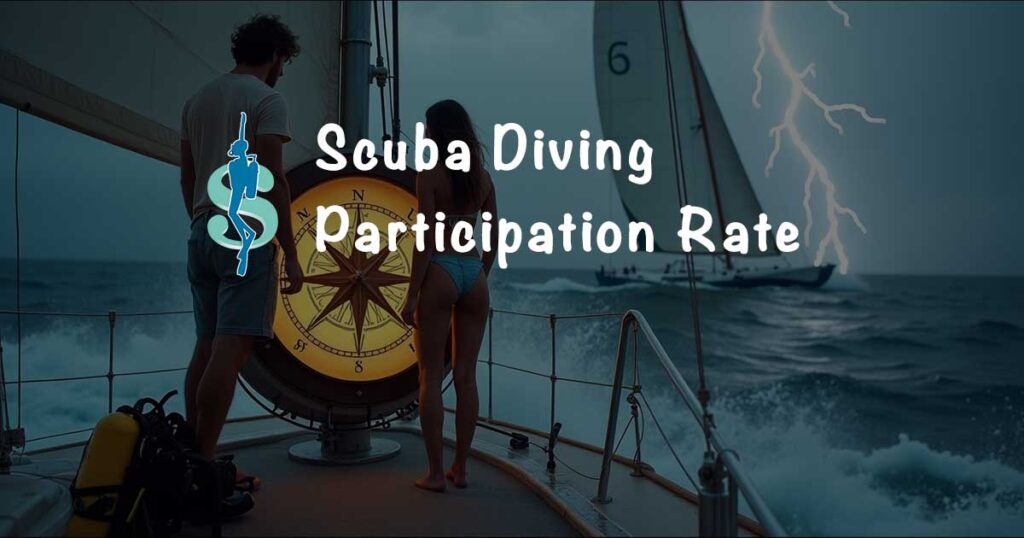Water Sport Market Report: Participation Rate for Scuba Diving, Snorkeling & Related Water Sports
Scuba diving participation rate compared to snorkeling, swimming, surfing & stand-up paddling in the USA.
Scuba diving is increasingly a casual activity done during a vacation that includes many other activities. Baby boomers were “all in” and went to dive resorts offering nothing but scuba diving. The younger generations are not that committed. Scuba diving is just one thing they do among other activities.
This has a considerable impact on dive businesses. For instance, traditional dive resorts and liveaboards should retool themselves to be more than scuba diving destinations. Meanwhile, there is downward pressure on the sale of dive gear since core divers were the ones most likely to buy a full set of scuba diving equipment. We should probably plan for lower sales numbers of hard goods, such as regulators and BCDs, and actively promote gear that people can easily travel with, like personal dive computers and wetsuits.
This post is part of our Dive Industry Compass series by the Business of Diving Institute and Darcy Kieran, author of:
Contents on This Page
TL;DR Overview
For scuba diving industry professionals, recent data from the USA reveals a critical shift: scuba diving saw strong growth in 2023, but this expansion was primarily fueled by casual divers who participate 1-7 times annually. Conversely, core diver participation (8+ dives/year) has not yet returned to pre-pandemic levels, indicating a broader trend where scuba is increasingly perceived as just one activity among many during a vacation.
This fundamental change directly impacts your business, creating downward pressure on sales of complete dive gear sets and suggesting a need to promote travel-friendly equipment, such as personal dive computers and wetsuits. Dive resorts and liveaboards are also encouraged to diversify their offerings beyond just diving to attract this new generation of less committed divers.
While snorkeling, a market that traditionally supported dive retailers’ sales, is in decline, with both casual and core participation shrinking, it still represents a considerable market in absolute numbers for gear sales and tours.
Crucially, adjacent water sports, such as Stand-Up Paddling (SUP) and Surfing, are experiencing significant growth, with surfing boasting a 7.4% average annual growth rate over the past five years. This presents a clear opportunity for dive shops to diversify their inventory and services, potentially incorporating SUP or surfing to attract a wider audience or offer activities for non-diving companions and surface intervals.
The success of other traditional activities, such as golf, in reinventing themselves and achieving sustained growth underscores an urgent need for the dive industry to critically reevaluate its current business models and marketing strategies to secure its future viability and capitalize on new trends.
Scuba Diving & Water Sports Participation Rate – Details
The participation rate in scuba diving among the American population is one set of data we can rely on.
We are severely lacking scuba diving industry statistics and, even more, reliable scuba market data. We are unsure of the current dropout rate. We can only estimate the size of the dive industry. However, we know the scuba diving participation rate in the USA because it’s part of an extensive study conducted annually by the SFIA (Sports and Fitness Industry Association) in their Topline Participation Report and by the OIA (Outdoor Industry Association) in their annual Outdoor Participation Report.
We will examine participation rates for scuba diving, but also for snorkeling and swimming, since these are activities that generate revenues for dive operators and dive gear manufacturers. Unfortunately, SFIA does not survey freediving or surface-supplied air (tankless) diving, and it does not make a distinction for tech diving.
Then, we will examine the participation rate in two adjacent water activities encountered in numerous dive centers: stand-up paddling and surfing. Finally, for comparison’s sake, we’ll examine the participation rate for golfing, an activity traditionally practiced by baby boomers.
The SFIA annual participation rates are generally accurate because they are based on the results of a random survey of the general population. We will never obtain a truly precise determination of the dive industry’s size until we do the same, as discussed in ‘How To Accurately Measure The Market Size of The Scuba Diving Industry’.
In the meantime, if you are interested in scuba diving market statistics and are on a limited budget, cancel your DEMA membership and join the SFIA. You will get much more valuable market information!
Core & Casual Participants
SFIA provides us with participation rates for “core” and “casual” scuba divers, which is vital information for dive gear manufacturers and travel operators. Core divers typically buy more gear and take more dive trips than casual ones.
Here are the definitions used by SFIA, which are the same we’re using in our strategic analysis of the dive industry:
- Casual: a scuba diver who went diving 1 to 7 times that year
- Core: a scuba diver who went diving 8 or more times that year
Water Sports Participation
To put water sports into perspective, here are the participation rates among Americans aged 6 and above in various categories of activities in 2023.
- Fitness Sports: 68%
- Outdoor Sports: 57%
- Individual Sports: 42%
- Team Sports: 26%
- Racquet Sports: 18%
- Water Sports: 16%
- Winter Sports: 10%
For the SFIA, “outdoor sports” include water sports even though water sports are also reported separately.
Every category experienced growth in participation in 2023.
Scuba Diving Participation
The rate of participation in scuba diving by Americans.
All Scuba Divers
Casual Scuba Divers
Core Scuba Divers
3 million participants represent about 1% of the 6+ American population.
In the USA, scuba diving experienced a strong year in 2023, with growth even compared to pre-pandemic levels. This is something we also observed in our State of the Dive Industry (SOTI) market report.
Western Europe also had a good 2023 year, but it was not the case in China and the Asia-Pacific. Therefore, we cannot use American market data to extrapolate to the rest of the world.
However, the more data points we have from various markets around the world, the more accurate our estimates on the size of the dive industry become.
A key factor to note here is that growth in scuba diving primarily comes from casual divers.
Casual participation in scuba diving in 2023 was the best year since 2015 and the second-best year of the last 10 years. Meanwhile, participation by core divers remained lower than pre-pandemic levels.
Overall, scuba diving participation grew by 1.8% on average annual growth (AAG) over a 5-year period. However, casual participation grew by 2.7%, while core participation shrank by 0.7% over the same period.
Scuba diving is not the only activity in which casual participation is increasing while core participation is declining. In sailing, for instance, casual participation was up 4.1% (5-Year AAG) in 2023, while core participation was down 3.2%.
However, some water activities, such as surfing, are experiencing tremendous growth among both casual and core participants. We will review these below.
We examine scuba diving participation rates by race, age group, and gender in our analysis of the socio-demographic profile of scuba divers.
Snorkeling Participation
All Snorkelers
Casual Snorkelers
Core Snorkelers
Snorkeling is on the decline, with the following annual average 5-year growth rates
- Overall: -0.8%
- Casual: -0.7%
- Core: -1.2%
The decline in snorkeling participation is not due to the pandemic. In fact, there was a slight bump up during 2020. However, the significant decline began in 2018, two years prior to the onset of the pandemic.
In absolute numbers, there are still more than twice as many snorkelers as scuba divers. Therefore, dive retailers and manufacturers can still count on snorkeling sales, while dive boat operators can still successfully fill boats for snorkeling tours. But it’s not a sector with promising growth at the moment.
Otherwise, snorkeling is even more of a casual activity, with 81% of the participants being casual in 2023, while 78% of scuba divers were casual participants.
You will find more information about snorkelers in our socio-demographic profile of snorkelers.
Swimming Participation
Many dive shops and manufacturers sell swim equipment, and a few dive centers offer swim lessons.
However, the data we have here specifically pertains to individuals participating in swimming for fitness purposes. It can still serve as a reference point for market data.
Swimming for fitness is growing at a slow pace of 0.6% (5-Year AAG), but the number of participants is nine times that of scuba divers.
However, what is more promising is that swimming for fitness is an aspirational activity among inactive people of every age group and every income level, while scuba diving and snorkeling are on none.
Stand-Up Paddling Participation
Stand-up paddling (SUP) has steadily grown year after year, and the COVID-19 pandemic didn’t stop it.
If you operate a dive shop and you haven’t looked at SUP yet, you probably should. And if you operate a dive site, stand-up paddling could be an exciting activity during surface intervals or for spouses who are not scuba diving.
In Lauderdale-by-the-Sea, Florida, we regularly see divers paddling to the reef from shore on a stand-up paddleboard and then towing it with a dive flag on it. My friends at BLU3, a manufacturer of surface-supplied air diving equipment, introduced me to this technique, and I’ve come to love it!
Surfing Participation
Numerous dive centers carry surfing products. In the USA, we especially see this combination in California and on the mid-Atlantic coast of Florida. Dive’n’Surf is quite famous for it in Redondo Beach, California.
Surfing is a pandemic success story. It simply exploded in 2020! After that, it returned to Earth in 2021 and 2022. However, surfing currently exhibits a 5-year annual average growth rate (AAGR) of 7.4%. I know several dive gear manufacturers and dive centers who would love such an increase in sales.
Golfing Participation
The dive industry is often compared to golfing because it has traditionally been a white baby boomer activity. So, let’s see if golfing experienced the same declining or soft growth years as scuba diving.
Golf has been growing steadily since 2018, with a 34% jump from 2018 to 2023.
So, yes, it is possible for a traditional “white baby boomer” activity to change and grow. Golfing re-invented itself a few years back, and it is paying off.
The dive industry urgently needs to get back to the drawing board and change both its business model and marketing strategies.
Video Summary & Thoughts
Have a look at more scuba diving market research, surveys, reports & statistics in Your Dive Industry Compass.
If the information in this post was valuable to you, would you consider buying me a coffee?
Either way, please help the dive industry by taking part in ongoing surveys. Results from our past scuba diving market studies are also available here.
Your Dive Industry Compass
Scuba Diving Market Research, Surveys, Reports & Statistics
Shifting Tides
Strategies for Today’s Scuba Divers
Living The Scuba Dream
Plan Your Scuba Instructor Career & Deep Dive the Plan
You may also be interested in The Immersion Zone (our podcast), Scubanomics (our newsletter for dive professionals), and our published books & reference guides.





